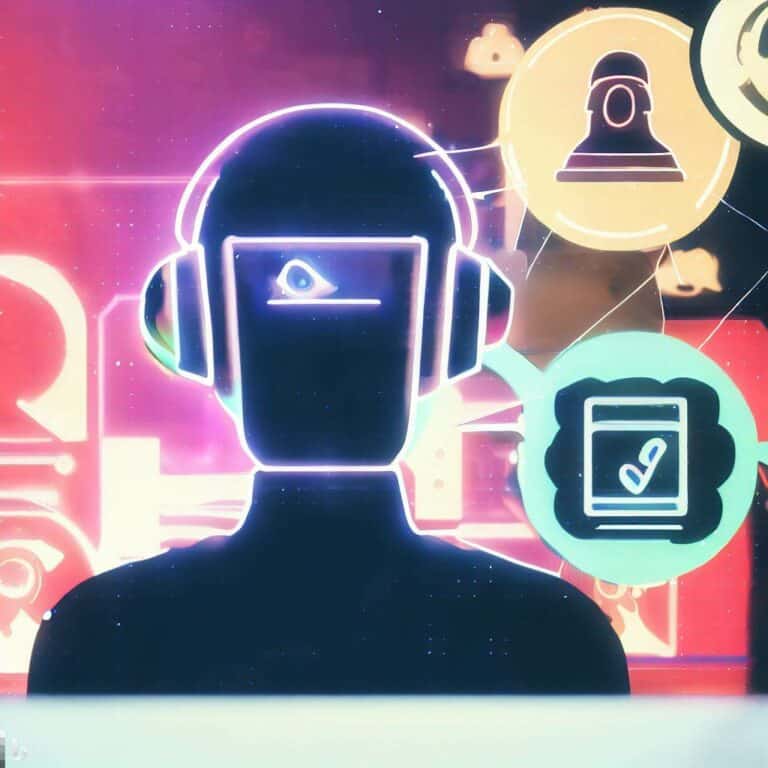Defining Client Retention: A Guide to Boost Your Business
Have you ever wondered, “What exactly does ‘define client retention’ mean?” If so, you’re not alone. Many people have heard the term, but don’t grasp its true meaning.
In the bustling world of business and customer relationships, “client retention” is more than just a buzzword. This concept holds immense power, shaping companies’ strategies and defining their success or failure.
Imagine running on an endless treadmill – continually acquiring new customers yet losing them just as fast because your existing ones keep leaving. Sounds exhausting right? This is where mastering the art of client retention comes in handy!
Hey, did you know that snagging a new customer can cost up to 25 times more than holding onto an existing one? Just food for thought.
Table of Contents:
- Understanding the Concept of Client Retention
- The Power of Personalization in Customer Retention
- Building Customer Loyalty through Social Media Engagement
- The Role of Customer Success in Client Retention
- Leveraging CRM Systems for Improved Client Retention
- Measuring and Improving Customer Retention Efforts
- The Future of Client Retention
- FAQs in Relation to Define Client Retention
Understanding the Concept of Client Retention
Client retention is more than just a trendy phrase; it’s essential for any prosperous enterprise. It refers to the strategies and actions companies take to keep their customers engaged and encourage repeat business. But why is client retention so important?
The simple answer lies in numbers – acquiring a new customer can be up to 25 times more expensive than retaining an existing one, according to Zendesk. This statistic alone should underline its importance.
The Role of Customer Experience in Client Retention
To understand this further, let’s delve into how enhancing customer experience can improve client retention. The modern consumer demands exceptional service at every touchpoint with your brand.
If you manage to meet or even exceed these expectations consistently, then congratulations. You’re already on the right path towards maintaining high levels of client retention. However, there are other considerations to be taken into account.
Digital Engagement: A New Avenue for Improving Client Retention
In today’s digital world where competition is just a click away, businesses need more than great products or services – they need strong relationships with their clients that stand out from the crowd. One such way of fostering these connections? Engaging inactive users through automated emails which have been shown to increase customer retention rates significantly.
This approach makes sure your brand stays top-of-mind while offering valuable content tailored specifically towards each individual user based on their preferences and past interactions with your company – talk about personalized attention.
The Power of Personalization in Customer Retention
Envision entering your go-to coffee shop and, without you uttering a syllable, the barista commences preparing your regular order. That’s personalization. Now apply this scenario to businesses dealing with their clients.
Research shows that personalized customer support significantly improves customer satisfaction and loyalty. It feels like someone understands us – it gives us a sense of belongingness.
Implementing Effective Personalized Strategies for Client Retention
If there were a magic potion to boost client retention, then ‘Personalization’ would be its main ingredient.
In an age where customers are flooded with choices at every turn, understanding their needs is not just important—it’s essential for survival. But how can we implement effective personalization strategies?
A simple start could be addressing clients by their names in emails or messages—no one likes being referred to as “Dear Valued Customer”. However, effective personalization goes beyond mere name-calling; it involves studying individual consumer behaviors and tailoring services accordingly.
Leveraging technology plays a key role here: from chatbots programmed with product recommendations based on past purchases to dynamic websites that change content according to user preferences – opportunities are endless.
<.– new paragraph>
Let me share my experience here – once I needed help fixing an issue with my laptop. The representative not only solved my problem but also noticed that I had queries related to software updates earlier too. So they proactively explained how I can easily do these updates myself next time.
This showed they knew who I was (personal touch), remembered our previous interactions (customer history), and went a step further to assist me (added value). As you can guess, I became a loyal customer.
So businesses out there, get creative. The more you customize your offerings to meet individual needs, the greater chance of not only keeping current customers but also transforming them into advocates for your company. After all, nothing beats word-of-mouth marketing.
<.– new paragraph>
Wrapping things up here –
Remember the power of personalization in client retention. It’s not just about calling clients by their names, but understanding and catering to their unique needs. Use tech tools like chatbots or dynamic websites for tailored services. Go beyond solving issues – anticipate needs, add value, and make your customers feel seen and valued.
Building Customer Loyalty through Social Media Engagement
Social media platforms are a bustling marketplace, filled with potential customers. Yet, the secret to unlocking this treasure trove lies not in selling but engaging. Engaging your audience helps build customer loyalty and improves client retention.
Using Social Media Platforms Effectively for Client Retention
The influence of social media interaction is unmistakable in terms of cultivating customer commitment. However, effective use demands more than posting promotional content or responding sporadically to comments.
Engagement means actively participating in conversations that matter to your clients – like being there for them during their ‘Eureka.’ moments and empathizing with them during challenges.
Effective Social Media Customer Retention Campaigns
A study shows brands creating change via social media have seen significant improvements in their customer loyalty and overall brand perception. The key here is authenticity – letting your customers see you’re not just another faceless corporation but an entity that shares common values.
In one successful case, a company used humor on its Twitter handle as part of its campaign strategy which resonated well with users leading to increased follower count & improved client retention.
Tips for Building Customer Loyalty Through Engagement:
- Create interactive posts: This could be anything from asking followers about their favorite product feature or hosting live Q&A sessions.
- Leverage user-generated content: Sharing photos or stories submitted by customers makes them feel valued and strengthens community ties.
- Show appreciation: Reward loyal followers by offering exclusive deals or sneak peeks at upcoming products.
- Consistent communication: Keep customers updated on the latest news or changes to your products/services.
- Personalize interactions: Responding personally to comments or messages, rather than with generic replies.
Winning at keeping clients through social media doesn’t happen in a snap. It’s a journey that needs time and work, but the reward is huge – devoted customers.
Winning over clients on social media isn’t about selling—it’s all about engagement. To boost customer loyalty and improve client retention, be part of the conversations that matter to your audience. Show authenticity, appreciate followers with exclusive deals, use interactive posts and user-generated content, keep communication consistent and personalized.
The Role of Customer Success in Client Retention
Customer success plays a pivotal role in client retention. What does this really involve? Creating positive experiences and helping clients reach their goals through your products or services is what customer success is all about.
Think of it like this: Imagine you’re at a restaurant where the staff not only provides excellent service but also anticipates your needs. They know when to refill your water glass without being asked and recommend dishes based on your preferences. You feel attended to and treasured as a patron, which prompts you to come back repeatedly. That’s the essence of customer success – anticipating needs, providing proactive help, exceeding expectations, ultimately leading to higher client retention rates.
Successful case studies have shown that implementing effective customer success strategies can improve client retention significantly.
Implementing Customer Success Strategies
A key aspect of fostering customer success is understanding what ‘success’ looks like from the customers’ perspective – then aligning our goals with theirs. If we’re successful in helping them succeed by meeting or surpassing these goals through exceptional support & service delivery; they’ll stick around longer. Hence defining ‘customer success’ becomes an integral part towards enhancing ‘Client Retention’.
We can start by segmenting customers according to their specific requirements and customizing our offerings accordingly. By tailoring our approach for each group effectively will ensure that we are catering accurately to diverse sets of expectations & objectives held by different clients groups within our base.
Leveraging Technology For Customer Success
In today’s digital age technology has become an enabler allowing businesses more than ever before; let us serve better while building deeper relationships with our customers. Leveraging customer relationship management (CRM) systems can help track client interactions, enabling businesses to provide timely and personalized service.
Automated emails sent at just the right time or chatbots answering frequently asked questions in real-time are examples of how technology is helping improve customer success efforts. These tools not only allow for more efficient use of resources but also ensure a consistent level of service that keeps clients coming back.
Customer success is the secret sauce to client retention. It’s about creating positive experiences, anticipating needs, and exceeding expectations. Implement strategies that align with your clients’ goals – they’ll stick around if you help them succeed. Leverage technology like CRM systems and automated emails for personalized service.
Leveraging CRM Systems for Improved Client Retention
Have you ever wondered how some businesses seem to keep their customers coming back, while others struggle? The secret sauce might just be a powerful Customer Relationship Management (CRM) system. This tool is not just about managing contacts but also serves as a potent weapon in improving client communication and service delivery.
It’s like having your own personal assistant who never forgets anything – birthdays, anniversaries, or even the last conversation with a customer. That level of detail can help create personalized experiences that lead to increased client retention.
An Overview of Best Practices when Using CRM Systems
The key lies in leveraging CRM systems effectively. A bit like getting the most out of your smartphone – it’s all there; we just need to use it right. Here are some actionable strategies:
- Data-Driven Insights: A robust CRM system will offer data-driven insights into customer behavior patterns. These analytics enable us to anticipate needs and tailor services accordingly.
- Automation for Consistency: We know consistency breeds trust. Automating tasks such as follow-ups ensures no balls get dropped in maintaining regular contact with clients.
- Social Media Integration: In today’s world where social media rules roost, integrating these platforms within your CRM enhances client communication and engagement.
Pretty neat stuff if used correctly.
Evidence Supports Effectiveness
You don’t have to take my word on this though; let’s look at what statistics say. “Businesses that effectively use CRM systems have reported improved customer satisfaction and increased client retention rates.” Now isn’t that a statistic worth pondering over?
The payoff here isn’t just for the big businesses; even smaller ones can reap rewards by employing CRM systems. Even smaller businesses can see tangible benefits by implementing CRM systems.
Is It Worth The Effort?
Absolutely. Remember how we spoke about creating personalized experiences for clients? Well, imagine doing that without having to remember every detail or manually track every interaction – the CRM system does all that heavy lifting.
Wrapping things up, even though
Unleashing the Power of CRM: Use a robust CRM system to keep track of customer details, automate regular follow-ups and integrate social media. This not only enhances communication but also fosters personalized experiences leading to better client retention.
Measuring and Improving Customer Retention Efforts
Your client base is your business’s lifeblood. Keeping them happy, engaged, and coming back for more isn’t just good practice—it’s survival.
Calculating customer retention rate can feel like a dark art at times, but the key metrics are straightforward: churn rate (the percentage of customers who leave during a given period), revenue churn (how much money you lose when they go), net promoter score (NPS) which measures how likely customers would recommend your brand to others, and repeat purchase rate—the proportion of clients returning to buy again.
The sobering fact? Acquiring a new customer can be up to 25 times pricier than retaining an existing one (SEMrush). That’s akin to paying through the nose for a fancy meal while leaving leftovers from last night’s feast untouched. It pays—literally—to invest in improving those metrics rather than constantly hunting fresh game.
Taking Your Client Retention Pulse
Digging into these stats will help pinpoint where efforts need beefing up. A high churn suggests problems with product or service quality; elevated revenue churn might mean you’re losing bigger-ticket clients more frequently. Lower NPS scores hint at overall dissatisfaction that could bleed into negative word-of-mouth marketing—not what any company wants.
Achieving Liftoff With Net Promoter Score (NPS)
NPS asks customers how likely they’d recommend your company on a scale of 0-10. Scores of 9-10 are ‘Promoters’, 7-8 are ‘Passives’ and anything lower is a ‘Detractor’. Subtracting the percentage of Detractors from Promoters gives your NPS. It’s like rocket science without the rockets: it doesn’t get more direct than asking customers if they’d vouch for you.
Boosting Repeat Purchase Rate
When customers keep on returning for additional items, you can be certain that you’re doing something accurately. To boost these repeat purchases, think about offering perks like
Keeping your clients happy and coming back for more is vital. Measure your client retention by checking out key metrics like churn rate, revenue churn, net promoter score (NPS), and repeat purchase rate. Remember: keeping an existing customer can be cheaper than finding a new one. Use stats to find where you need improvement. And always aim to boost those repeat purchases.
The Future of Client Retention
As the business landscape evolves, so too does our understanding of client retention. The future seems to be pointing towards a blend of technology and personalized service, as businesses strive to anticipate and adapt to changing customer expectations.
We’re not just talking about your standard loyalty programs here. We’re seeing an increasing shift towards leveraging emerging technologies like AI and machine learning to better understand customer behavior and predict their needs even before they do.
Tech-Savvy Customer Retention Strategies
Think Siri or Alexa but for your brand; virtual assistants that know what your customers want because they’ve learned from previous interactions. This kind of personalized attention is becoming less science fiction and more everyday reality.
Retaining existing customers is far more cost-effective than acquiring new ones, with the latter costing up to 25 times more. Remember this key stat: acquiring a new customer can be up to 25 times more expensive than retaining an existing one.
Social Media: A Game Changer in Client Retention
If you think social media platforms are only good for getting likes on cute cat videos, think again. Businesses are finding value in engaging with customers through these channels – creating communities around their brands, responding quickly (and publicly) to issues or complaints, even predicting trends based on social chatter. Brands that create change via social media have seen significant improvements in both customer loyalty and overall brand perception.
A New Era Of CRM Systems
The rise of tech doesn’t mean we’re moving away from human interaction though – far from it. We’re seeing a resurgence in the importance of good old-fashioned customer service, but with a tech twist. CRM systems are now being utilized to enhance client communication and improve service delivery, ultimately boosting client retention.
In essence, it’s about marrying technology with empathy – understanding your clients on a deeper level while using data-driven insights to serve them better. The aim for the future is to ensure that customers never feel the need to go elsewhere, not just retaining them.
Embrace the future of client retention by combining tech advancements with personalized service. Utilize AI and machine learning to predict customer needs, while maintaining strong social media engagement for brand loyalty. Harness CRM systems to enhance communication, but remember: it’s not just about retaining customers; it’s making them never want to leave.
FAQs in Relation to Define Client Retention
What is meant by client retention?
Client retention refers to strategies and actions companies take to keep their customers returning and continue buying or using services.
What is an example of customer retention?
An example could be a loyalty program where customers earn points for every purchase, encouraging them to buy more from the same company. Here’s more on this.
What is customer retention and why is it important?
Customer retention involves keeping existing clients engaged with your business. It’s vital because retaining a client costs less than acquiring new ones, which boosts profitability.
What is good customer retention?
A good customer retention rate varies by industry but typically, anything over 80% indicates strong client loyalty. But remember, always aim higher.





